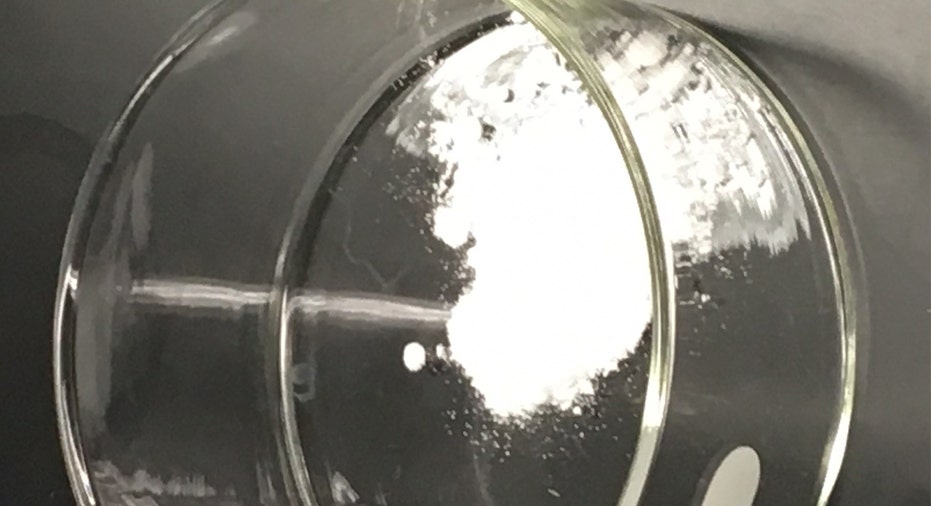DEA: Made-in-China Lethal Opioid Fueling U.S. Drug Epidemic

A homemade designer version of fentanyl, the highly addictive opioid which is similar to morphine but is 50 to 100 times more potent, has been the center of drug busts across the country this month—with law enforcement pinpointing its origin from underground labs in China. The DEA says the China-U.S. supply is further fueling the country’s drug epidemic.
“This stuff is unbelievably potent. It is so powerful that even a tiny amount can kill you,” DEA spokesman Rusty Payne tells FOX Business. “China is by far the most significant manufacturer of illicit designer synthetic drugs. There is so much manufacturing of new drugs, [it’s] amazing what is coming out of China. Hundreds of [versions], including synthetic fentanyl and fentanyl-based compounds.”
Fentanyl, the opioid that killed singer Prince and is often prescribed to late-stage cancer patients, has been classified as a schedule II drug in the U.S. for decades, which makes it a felony to sell or use without a prescription. China only made the drug illegal in 2015, and at that point black market Chinese labs began increasing production of their own versions, including the one turning up recently across the country called furanyl fentanyl.
“While heroin gets harder to buy on the street or from a dealer, fentanyl comes via FedEx,” Brad Lamm, CEO of Intervention.com, tells FOX Business.
Authorities say dealers across the country have been lacing heroin with the potent analog. Payne adds that Mexican drug cartels are now switching from heroin to fentanyl because of the high-profit margin.
“A kilogram of fentanyl is so much [more] lucrative for a trafficker than a kilogram of heroin, because you can mix a very small amount of fentanyl with a lot of other things and sell it on the streets and take that kilogram a lot farther. And the profits are so much greater,” he says.
But the powder alone is deadly.
“Fentanyl is scary because if it touches your skin you can have major side effects to it, including death,” adds Payne.
The cost of counterfeit pills containing fentanyl or fentanyl-related compounds retail for $10 to $20 per pill in the U.S. (Depending on the purity of the fentanyl and the dosage).
Brooklyn District Attorney Eric Gonzalez announced this week details on a mail-order furanyl fentanyl smuggling ring bust. The operation had been bringing the drug -- which has been dubbed “White China” -- into the U.S from Asia. NYPD Chief of Detective Bob Boyce said that this was the first time investigators have seen this type of fentanyl in New York City.
Also this week, Cincinnati Customs and Border Protection agents said they seized 83 shipments of illegal synthetic drugs, including 36 pounds of furanyl fentanyl, from China. However, law enforcement said the six shipments of furanyl fentanyl were originally destined for Camden, New Jersey.
Meanwhile, local and state police in Boston this week recovered approximately 520 grams of a white powder that tested positive for fentanyl from behind a freezer in a restaurant basement. Suffolk County District Attorney Dan Conley called it a “major” drug seizure, but did not disclose if the drug was furanyl fentanyl, or if it was made in China.
According to the DEA, fentanyl overdose outbreaks have recently hit Ohio, New York, Pennsylvania, Michigan, Illinois, Alaska, Louisiana and Oregon. In 2015, opiates factored in 33,091 U.S. deaths, which was up more than 4,000 from the previous year, according to the U.S. Center for Disease Control and Prevention.
Payne says China has “really stepped up lately,” working hand-in-hand with the U.S. to help curb this growing problem. In January, DEA acting administrator Chuck Rosenberg was invited to China to meet with Beijing drug control officials at the invitation of the China Ministry of Public Security.
Lamm, who runs a drug and alcohol rehab center in California, warns that while the drug “makes you feel great, like the best high ever,” the potency makes it extremely easy to overdose on.
“It mellows you out to such an extent that you could potentially stop breathing,” he says.



















